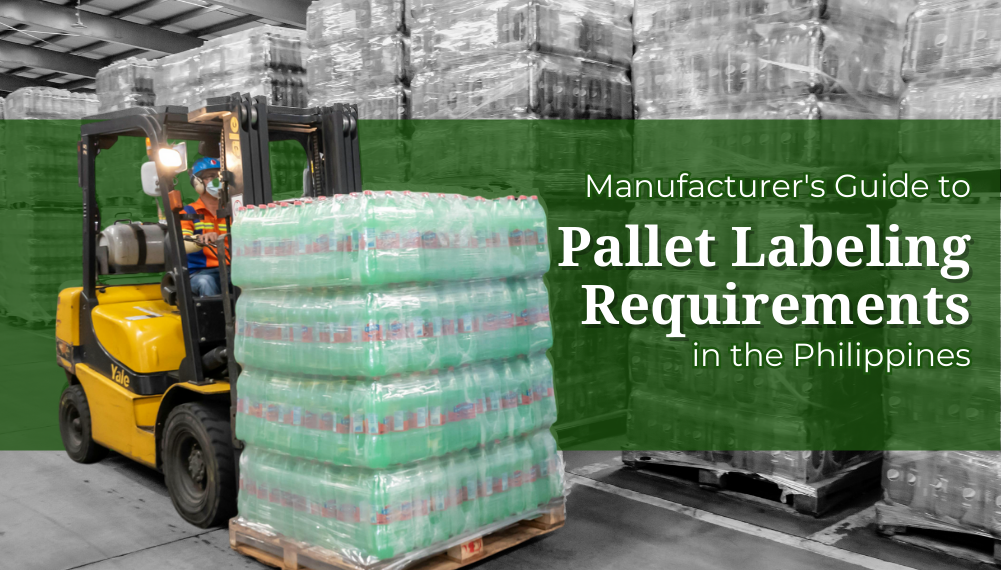Losing shipments or products is one of the worst scenarios that a manufacturer can encounter. To remedy this, it is important to implement proper pallet labeling practices. This also prevents misinformation and shipping problems with your products. There is no pallet labeling standard universally applicable across various industries; however, common characteristics such as barcodes, shipping, and product information are a must in labeling.
Below is a basic guide to pallet labeling requirements in the Philippines. Learn the best ways to place your pallet labels, as well as the necessary information that must be displayed on your label.
The Essentials of Pallet Labeling in the Philippines
Why is it important to label pallets?
Pallet labeling is necessary to facilitate seamless operations that require inventory and shipment tracking. It also protects a manufacturer’s goods during shipment. Good labeling practices are most beneficial for logistics and the continuity of the supply chain. It also builds trust between the manufacturer and consignee through relaying accurate shipment data.
Although there is no universal pallet labeling standard, international shipments typically adhere to the Global Standard One Serial Shipping Container Code (GS1-128 SSCC) barcode that includes basic information about the products contained in a pallet.
In the Philippines, label regulations vary across markets and industries. For example, food, beverages, and other consumables require a particular set of information for primary packaging and labeling. On the other hand, pallet labeling standards can be agreed upon by the manufacturer and consignee, but must comply with the GS1 requirements.
Pallet Labeling Requirements in the Philippines
Pallet Labeling Data
The label is typically divided into two main sections, the top section includes the following human-readable information:
- Sender Business Name / Representative
- Sender Address and Details
- Recipient Business Name / Representative
- Recipient Address and Details
- Billing Information
- Route Information
- Product Dimensions and Weight
- Shipment and Transport Details
The bottom section includes scannable information, consolidated using the SSCC barcode format:
- Application Identifier
- Extension Identifier
- GS1 Company Prefix
- Serial Number
- Control Number
Pallets that include trade items like food, cosmetics, and pharmaceuticals are labeled with information regarding its type and quantity. The GTIN is used to register this data.
- Content of a pallet
- Count or quantity within a pallet
- Lot number
- Best before / Sold by date
- Expiration date
Barcodes
Aside from the GS1 SSCC and GTIN, other optional barcode formats generally depend on the manufacturer. Companies may use QR codes or RFID tags to label shipments with relevant information not included in the commonly used data above. It can include product codes, internal product categorization, handling or storage instructions, and the like.
Sizes
A good practice for pallet labeling in the Philippines is adhering to the proper label sizes. It is recommended to use large, weatherproof labels of at least A5 (6 x 8 inches) for pallets.
Other pallet label dimensions vary depending on data requirements and pallet sizes. Industry standards can also affect pallet labeling in the Philippines.
Placement
Labels must be placed between 16 and 32 inches from the bottom of the pallet.
For units sized under 16 inches, the label must be placed as high as possible, while at the same time, protecting the barcode and ensuring readability.
Independent pallets or units should be labeled on two opposite sides with identical data. Keep one label visible at all times. Stacked pallets (those physically connected with straps, ties, or shrink wrap) should be considered as independent units as well, and bear one pair of labels.
Build a Reliable Pallet Label Printer and Applicator System
To achieve maximum pallet labeling efficiency, invest in high-performing label printers and applicators for your logistic units.
The Evolabel T63 Thermal Transfer Printer creates large labels for pallet and box labeling. It meets the GS1 standards with its print capability of up to A5 format labels for labeling more than one side of a unit. This smart pallet label printer is built to handle both thermal transfer and direct transfer technology in various applications.
Meanwhile, some label applicators are built specifically for achieving pallet labeling requirements in the Philippines. The Evolable FlexWipe Pallet Labeling System is safe and cost-effective, an ideal solution for precise and accurate label placement.
ALSO READ: Everything You Need to Know About the Evolabel T43 Thermal Transfer Printer
Invest in top-quality pallet labeling essentials by partnering with Elixir Industrial Equipment. We are a trusted supplier of consumables, equipment, and machinery you need to achieve various pallet labeling requirements in the Philippines. Talk to us today to get a quote.

